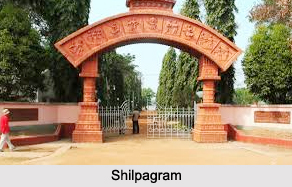 Shilpigram or Srijan Shilpigram is located in Shantiniketan area in Birbhum District of West Bengal. It is the place where the visitors see the culture and traditions of India and there is a platform to communicate with the artists of Indian states.
Shilpigram or Srijan Shilpigram is located in Shantiniketan area in Birbhum District of West Bengal. It is the place where the visitors see the culture and traditions of India and there is a platform to communicate with the artists of Indian states.
Location of Shilpigram
Shilpigram is developed in between Shantiketan and Sriniketan. It maintains an art gallery for creative artists, artisans and the photographers. The cultural programmes and exhibitions of artworks of wide India are arranged from time to time.
Foundation of Shilpigram
Shilpagram is a magnificent place with delightfully decorated tribal huts all around the pavillion, depicting the lifestyle of various indigenous tribes from different parts of India. Shilpagram gives a quick insight of tribal life of India especially the Northeast India and their art and culture. Srijan Shilpigram is developed and maintained by EZCC (Eastern Zonal Cultural Centre). They also organize cultural programms and concerts in the outdoor arena in "Srijani".
Focus of Shilpagram
Srijani Shilpagram showcases homes, lifestyle, handicrafts of the Eastern and North-Eastern states in India. Srijani Shilpagram has spread across sprawling grounds, the place is designed to be a hub for rural artisans to sell their fabrics, handicrafts. It is a government initiative. Srijani Shilpagram started in 2008 and includes representation from states such as West Bengal, Odisha, Bihar, Chhattisgarh, Jharkhand, Sikkim, the seven sisters in North-East and Andaman and Nicobar Islands too.
Tourism in Shilpagram
Shilpagram is an absolute delight to see the mud, bamboo, straw huts with beautiful murals on the walls and exhibits daily life in the grounds outside. Srijani Shilpagram allows the tourists to see cultural heritages of India. The fabrics, sarees, dresses and handicrafts of these states are available at the stalls close by. One can buy the textiles and the crafts from the artisans of Srijani Shilpagram. A tour of the whole place takes about 2 hours to observe the culture and the heritages of India.
Visiting Information
Srijani Shilpagram is accessible with both road ways and railways. The nearest railhead is Bolpur in Birbhum District of West Bengal. It can be reachable by car also. The toto vans, auto and cabs can take one near Srijani Shilpagram.



















